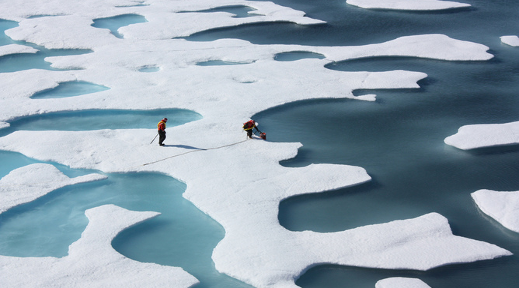Uncertainty in climate projections arises from several different sources. For example, the future emissions scenario is not known, so the usual approach is to run several to compare plausible futures. In addition, each climate model produces a different change in climate. However, on regional spatial scales and for the next couple of decades, it is the internal variability of climate which dominates. These natural climate fluctuations provide an irreducible limit on the precision with which we can make predictions on such spatial and temporal scales – but how large is this limit? Continue reading Irreducible uncertainty in near-term climate projections
Category Archives: projections
An apples to apples comparison of global temperatures
When comparing global temperatures estimated from observations with climate model simulations it is necessary to compare ‘apples with apples’. Previous posts have discussed the issues of incomplete observational data, but a new paper by Cowtan et al. quantifies the influence of different observational data types. Continue reading An apples to apples comparison of global temperatures
How not to use daily CMIP5 data for impact studies
A new paper out this week in PLOS Biology uses some CMIP5 simulations of daily mean surface air temperature as part of a larger analysis on the change to future plant growing days. The description of the analysis suggests they have not used the simulations appropriately to arrive at their conclusions. Here I highlight a couple of possible pitfalls in using such data in impact studies. Continue reading How not to use daily CMIP5 data for impact studies
Ozone birthday
Almost exactly 30 years ago a paper by Farman, Gardiner & Shanklin appeared in Nature describing the loss of ozone in the Antarctic and suggesting that the presence of chlorine compounds high in the cold polar winter atmosphere were responsible. Continue reading Ozone birthday
Hiatus delays unprecedented warming rates
Current global temperatures are often discussed in terms of their unprecedented nature when compared to the last few thousand years. An interesting paper in Nature Climate Change by Steven J Smith and colleagues examines the rate of warming projected by the CMIP5 ensemble and suggests that the rate of warming is unprecedented also. However, we note here that their projections are not constrained by the current observations which do not show such strong warming rates at present, and are unlikely to do so in the next few years. Continue reading Hiatus delays unprecedented warming rates

Arctic sea-ice decline erratic as expected
Imagine a ball bouncing down a bumpy hill. Gravity will ensure that the ball will head downwards. But, if the ball hits a bump at a certain angle it might move horizontally or even upwards for a time, before resuming its inevitable downward trajectory. This bouncing ball is an analogy for the behaviour of Arctic sea-ice.
Post based on Swart et al., Nature Climate Change, or see a less technical summary. Continue reading Arctic sea-ice decline erratic as expected
Projected changes of precipitation and temperature extremes
Model projections of heavy precipitation and temperature extremes include large uncertainties. However, disagreement between individual simulations primarily arises from internal variability, whereas models agree remarkably well on the forced signal.
Post based on Fischer et al., 2014, Geophys. Res. Lett.
Continue reading Projected changes of precipitation and temperature extremes
Wet get drier (eventually)?
A prevailing paradigm of how rainfall patterns will change on a warming Earth is that the hydrological cycle strengthens causing wet regions to get wetter and dry regions to get drier.
However, this is not always the case: Hawkins, Joshi & Frame (2014) highlight one particular effect – the movement of the Inter-Tropical Convergence Zone (ITCZ) – as a key long-term driver of rainfall changes that do not follow this ‘wet get wetter’ paradigm. Continue reading Wet get drier (eventually)?